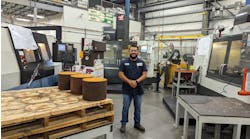What’s the True Cost of an Ignorant Supply Chain?
How difficult is it to build an airplane? According to Ian Poulton, senior finance manager with PPG Aerospace, “The coordination of an aerospace supply chain is, in a word, horrific.”
Speaking at the recent IW Manufacturing & Technology 2019 show in Pittsburgh, PA, Poulton explained that a typical airplane window has close to 100 unique components per window per plane. And every window has to be tested for impact (including birds) and temperature.
“Every day there’s a different issue that needs to be addressed,” he noted, “from human resources issues to customer deliveries to capacity constraints, and so on.” On the HR side, for instance, he pointed out that making an airplane window is a very labor-intensive process—not something that an be automated—and it takes a long time to train somebody to properly manufacture a window.
“Ignorance is bliss,” he said, describing how each of the different departments of the company would say everything in their area was fine, but in reality, every department was relying on expediting the most immediately pressing task or process to ensure things got done on time, resulting in additional costs.
“The reality was, we didn’t know how bad we were—it was just the way it always was, with us always putting out fires, rather than focusing on how we could prevent these last-minute issues from becoming so frequent.”
That situation, fortunately, changed when PPG was introduced to integrated business planning. IBP is a business planning process developed by management consulting firm Oliver Wight that extends the principles of sales and operations planning (S&OP) throughout the whole supply chain process.
After conducting a “health check” of its operations, PPG Aerospace determined that its prognosis was “not well.” Some of the unhealthy conditions included:
- Overweight. The company was carrying too much inventory, and had run out of storage space.
- Stressed. Too many late shipments from suppliers and too many late deliveries to customers. The go-to solution for both problems was expediting orders through the plant.
- Back Pain. PPG Aerospace couldn’t manage all the demands that were being put on the factory.
- Family Feuds. The various operations of the company weren’t aligned with the needs of the customers. It was hard to discern exactly what the plan was, or who was in charge.
As David Goddard, a principal with Oliver Wight, explained, the first step in any company’s supply chain transformation should be to improve internal communications. “You can’t start solving problems until everybody can agree on the data,” he pointed out. Once companies have identified the best way to communicate—a process that Goddard said could take one to three months—they can move on to problem solving, and then to problem prevention, and finally, to tactical strategic decision-making.
“Nobody was talking to each other, and everybody was in silos,” Poulton recalled. “We weren’t generating enough cash, and we didn’t have a clear plan.”
PPG Aerospace began its IBP journey, with the help of Oliver Wight, by focusing on fixing its sourcing and supplier management situation. “Sourcing was our ‘burning platform,’ the one we were always fire-fighting,” Poulton explained. “
The company developed a “one plan” financial strategy that is used by purchasing, by production, by virtually every relevant department. “Today, everybody has the same set of numbers to work off of,” he said.
Although he currently runs PPG Aerospace’s finance department, Poulton’s career has bridged both the finance and the supply chain disciplines, as he’s also served as the company’s global supply chain director and before that, he was a strategic sourcing manager. “If you’re looking for people to run your supply chain, take a look in your finance department,” he suggested. “Only supply chain and finance have full end-to-end visibility of a company’s entire value stream.”
Among other best practices, PPG Aerospace adopted rough cut capacity planning, which Oliver Wight defines as “the process of converting the production plan and/or the master production schedule into capacity needs for key resources: manpower, machinery, warehouse space, vendors’ capabilities, and in some cases, money.” Thanks to RCCP, “we’re now able to make more product at a lower cost,” Poulton said.
PPG Aerospace was so successful in its supply chain transformation that it now instructs its suppliers in how to adopt IBP practices, a move that has led to the end of the days when suppliers would regularly raise prices. The key is that PPG became a business partner with its suppliers.
“IBP isn’t easy, but it is rewarding,” Poulton said, adding, “It’s the gift that keeps on giving.”




